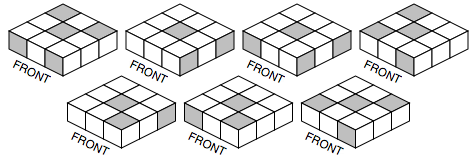Rubik’s Cube Solution & Extras
| Author: | David Goodger |
|---|---|
| Contact: | goodger@python.org |
Contents
Rubik’s Cube Solution
Summarized from the solution pages mirrored at <http://jjorg.chem.unc.edu/personal/monroe/cube/Denny3x3/> and <http://www.helmsoft.org/cube/rubikscube/>, written by Denny Dedmore. The initial instructions (for completing the first/top layer) and move icon legend have been omitted for brevity.
Middle Layer Edges
Find a middle-layer edge piece in the bottom row. Rotate it under the matching side center color.
To move it up & right:



 ,
, 



To move it up & left:



 ,
, 



If an edge piece is already in place but backwards, simply apply the above sequences twice. Put a bogus piece from the bottom row in its place, moving the problem piece to the bottom.
Bottom Corners
Flip the Rubik’s Cube upside down; the former, unfinished bottom side becomes the top. Choose a side color, which becomes the front.
Find the two corners on the top layer with the front side’s color (regardless of orientation). They’ll either be adjacent or diagonally opposite.
Adjacent Corners
Rotate the top layer so the corners matching the front color are in front. If they need to be swapped:



 ,
, 


 ,
, 


Diagonally Opposite Corners
Rotate the top until the top left corner is in the correct position and then perform the following procedure to move the other corner into the top right position:



 ,
, 


 ,
, 


Swapping The Other Two Corners
If the remaining corners need to be swapped, turn the cube around 180 degrees and perform the following procedure:



 ,
, 


 ,
, 


Finishing The Corners
Spin the entire cube (keeping the top up) until the top center colors match one of the 7 patterns below (ignore other colors).

Orient the cube as shown above and perform this sequence:



 ,
, 


 ,
, 

If the corners are not quite finished, match up the new pattern and perform the sequence once again. This process may have to be performed up to three times.
The Last Four Edges
Usually at least one of the 4 remaining edges will be in place. Find that piece and rotate the cube until it is positioned in the front. If no edge is in place, choose any side to be the front. Perform the sequence below once then start over.
Perform the moves below to put all 4 pieces in their correct locations:



 ,
, 



This step may have to be performed twice to get all edges in place.
Adjacent Flipped Edges
Orient the flipped edges so one is in the front and one is to the right. Then perform this sequence:



 ,
, 


 ,
, 


 ,
,



 ,
, 


 ,
, 

Extras
Patterns
Source: Pretty Rubik’s Cube patterns with algorithms
Six Spots
Permute the centers of the top, front, & right sides (T → F → R → T), as well as the down, bottom, & left sides (D → B → L → D).
U D' R L' F B' U D'
Cross
Rotate each corner in-place, resulting in a cross on each face:
R2 L' D F2 R' D' R' L U' D R D B2 R' U D2
Cube in a Cube in a Cube
Rotate the URF & DLB corners, 2×2 & 1×1.
U' L' U' F' R2 B' R F U B2 U B' L U' F U R F'